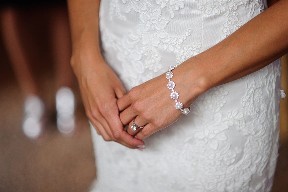After you spend good money to have your wedding gown cleaned and preserved, you would assume that you had done everything you should to care for your gown and you can relax. Right? Maybe not. There is a great deal of difference between dry-cleaners, especially when it comes to wedding gown care. In particular, silk gowns require experienced workers, familiar with the different silk weaves and the proper way of handling each.
While 75% of wedding dresses are made of synthetic fabrics which are easier to clean and care for (some exceptions), that other 25% of silk wedding gowns require skill and experience for proper care. Many workers at dry-cleaning shops are just minimum wage staff, with little training on specific fabrics and stain removal. Buyer beware! Catastrophes can occur.
We received an email this past week from a very unhappy bride. She took her beautiful wedding gown to her local dry-cleaner the Wednesday after her wedding last month. But when she picked it up a few days later, she found that the previously white gown fabric had changed to a yellowish color and the satin had lost it’s sheen as well. She wrote to us asking if we could fix the problems.
I suggested that the first thing she do is contact the Dry Cleaning and Laundry Institute who provides a service of testing the dress to determine what had transpired. The DLI looked at the gown and confirmed my suspicions, that the dress had been cleaned in water with improper chemicals (probably alkaline). The color can be restored (acidic treatment) but the sheen cannot. This bride discovered the hard way that not all wedding gown cleaners are alike.


| Before Cleaning | After Cleaning |
Do your research before taking your wedding gown to your local cleaner. Please read more about proper wedding gown cleaning and screening your local dry cleaner by reading our Wedding Gown Cleaning and Preservation Guide.
